
Albrecht Dürer, sometimes spelled in English as Durer, was a German painter, printmaker, and theorist of the German Renaissance. Born in Nuremberg, Dürer established his reputation and influence across Europe in his twenties due to his high-quality woodcut prints. He was in contact with the major Italian artists of his time, including Raphael, Giovanni Bellini, and Leonardo da Vinci, and from 1512 was patronized by Emperor Maximilian I.
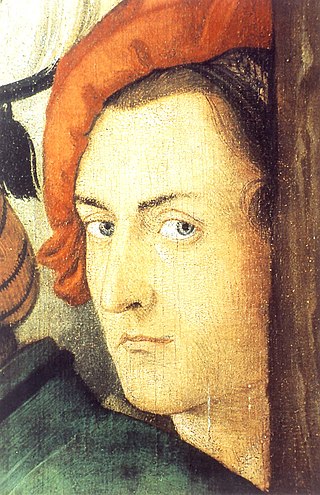
Hans Baldung, called Hans Baldung Grien,, was a painter, printer, engraver, draftsman, and stained glass artist, who was considered the most gifted student of Albrecht Dürer and whose art belongs to both German Renaissance and Mannerism.

Lucas Cranach the Elder was a German Renaissance painter and printmaker in woodcut and engraving. He was court painter to the Electors of Saxony for most of his career, and is known for his portraits, both of German princes and those of the leaders of the Protestant Reformation, whose cause he embraced with enthusiasm. He was a close friend of Martin Luther. Cranach also painted religious subjects, first in the Catholic tradition, and later trying to find new ways of conveying Lutheran religious concerns in art. He continued throughout his career to paint nude subjects drawn from mythology and religion.

Adriaen Isenbrandt or Adriaen Ysenbrandt was a painter in Bruges, in the final years of Early Netherlandish painting, and the first of the Dutch and Flemish Renaissance painting of the Northern Renaissance. Documentary evidence suggests he was a significant and successful artist of his period, even though no specific works by his hand are clearly documented. Art historians have conjectured that he operated a large workshop specializing in religious subjects and devotional paintings, which were executed in a conservative style in the tradition of the Early Netherlandish painting of the previous century. By his time, the new booming economy of Antwerp had made this the centre of painting in the Low Countries, but the previous centre of Bruges retained considerable prestige.

The Nuremberg Chronicle is an illustrated encyclopedia consisting of world historical accounts, as well as accounts told through biblical paraphrase. Subjects include human history in relation to the Bible, illustrated mythological creatures, and the histories of important Christian and secular cities from antiquity. Finished in 1493, it was originally written in Latin by Hartmann Schedel, and a German version was translated by Georg Alt. It is one of the best-documented early printed books—an incunabulum—and one of the first to successfully integrate illustrations and text.

The German Renaissance, part of the Northern Renaissance, was a cultural and artistic movement that spread among German thinkers in the 15th and 16th centuries, which developed from the Italian Renaissance. Many areas of the arts and sciences were influenced, notably by the spread of Renaissance humanism to the various German states and principalities. There were many advances made in the fields of architecture, the arts, and the sciences. Germany produced two developments that were to dominate the 16th century all over Europe: printing and the Protestant Reformation.
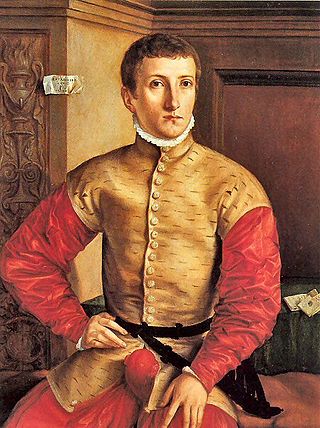
Georg Pencz was a German engraver, painter and printmaker.

Sebald Beham (1500–1550) was a German painter and printmaker, mainly known for his very small engravings. Born in Nuremberg, he spent the later part of his career in Frankfurt. He was one of the most important of the "Little Masters", the group of German artists making prints in the generation after Dürer.
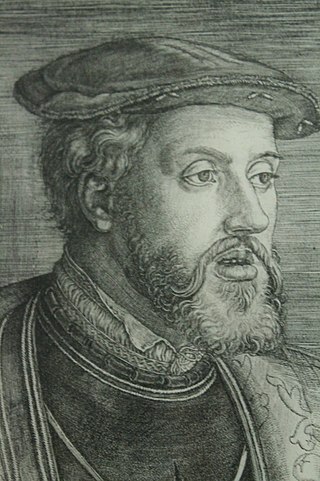
Barthel Beham (1502–1540) was a German engraver, miniaturist, and painter.

Dürer's Rhinoceros is the name commonly given to a woodcut executed by German artist Albrecht Dürer in 1515. Dürer never saw the actual rhinoceros, which was the first living example seen in Europe since Roman times. Instead the image is based on an anonymous written description and brief sketch of an Indian rhinoceros brought to Lisbon in 1515. Later that year, the King of Portugal, Manuel I, sent the animal as a gift for Pope Leo X, but it died in a shipwreck off the coast of Italy. Another live rhinoceros was not seen again until Abada arrived from India to the court of Sebastian of Portugal in 1577.
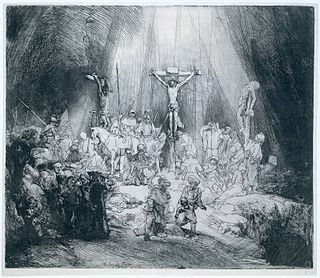
An old master print is a work of art produced by a printing process within the Western tradition. The term remains current in the art trade, and there is no easy alternative in English to distinguish the works of "fine art" produced in printmaking from the vast range of decorative, utilitarian and popular prints that grew rapidly alongside the artistic print from the 15th century onwards. Fifteenth-century prints are sufficiently rare that they are classed as old master prints even if they are of crude or merely workmanlike artistic quality. A date of about 1830 is usually taken as marking the end of the period whose prints are covered by this term.

Jacopo de' Barbari, sometimes known or referred to as de'Barbari, de Barberi, de Barbari, Barbaro, Barberino, Barbarigo or Barberigo, was an Italian painter, printmaker and miniaturist with a highly individual style. He moved from Venice to Germany in 1500, thus becoming the first Italian Renaissance artist of stature to work in Northern Europe. His few surviving paintings include the first known example of trompe-l'œil since antiquity. His twenty-nine engravings and three very large woodcuts were also highly influential.
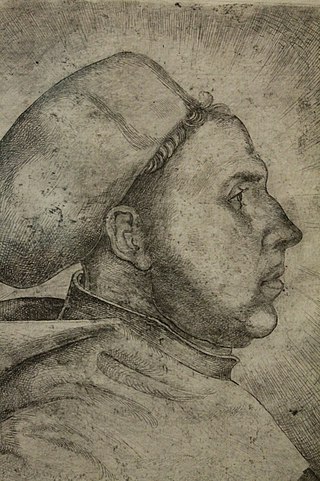
Daniel Hopfer was a German artist who is widely believed to have been the first to use etching in printmaking, at the end of the fifteenth century. He also worked in woodcut. Although his etchings were widely ignored by art historians for years, more recent scholarship is crediting him and his work with "single-handedly establishing the salability of etchings" and introducing the print publisher business model.

Jacob Cornelisz van Oostsanen was a Northern Netherlandish designer of woodcuts and painter. He was one of the first important artists working in Amsterdam, at a time when it was a flourishing and beautiful provincial town.
Christ and the Sheep Shed is a polemical woodcut made in 1524 by the Nuremberg artist Barthel Beham, one of the Little Masters. Created in the early part of the Protestant Reformation, this woodcut illustrates the beliefs of the artist, as well as other reformers, about the manipulation of the Catholic hierarchy. His work was influenced by reformers, such as Martin Luther, as well as other artists like Barthel's older brother, Sebald. This woodcut was created during the height of the peasant revolts and, though they were less severe in Nuremberg than in other parts of Germany, the social implications were greatly felt. Though there is little information on this particular woodcut, it represents much of the political and social aspects of the Reformation, and interpretation provides insight on the artist's perspective of the era. The distribution of woodcuts was one of the most effective modes of propaganda during the Protestant Reformation. Christ and the Sheep Shed depicts the radical sentiment of the period in which it was created, and portrays the wide-ranging effects of the Reformation and religion on all aspects of German culture. The image is unrealistic as an authentic situation. However, it was used as a symbolic interpretation of the Catholic Church’s manipulation over people and their faith.

The Triumphal Arch is a 16th-century monumental woodcut print commissioned by the Holy Roman Emperor Maximilian I. The composite image was printed on 36 large sheets of paper from 195 separate wood blocks. At 295 × 357 centimetres (116 × 141 in), it is one of the largest prints ever produced and was intended to be pasted to walls in city halls or the palaces of princes. It is a part of a series of three huge prints created for Maximilian, the others being a Triumphal Procession which is led by a Large Triumphal Carriage ; only the Arch was completed in Maximilian's lifetime and distributed as propaganda, as he intended. Together, this series has been described by art historian Hyatt Mayor as "Maximilian's program of paper grandeur". They stand alongside two published biographical allegories in verse, the Theuerdank and Weisskunig, heavily illustrated with woodcuts.

The Little Masters, were a group of German printmakers who worked in the first half of the 16th century, primarily in engraving. They specialized in very small finely detailed prints, some no larger than a postage stamp. The leading members were Hans Sebald Beham, his brother Barthel, and George Pencz, all from Nuremberg, and Heinrich Aldegrever and Albrecht Altdorfer. Many of the Little Masters' subjects were mythological or Old Testament stories, often treated erotically, or genre scenes of peasant life. The size and subject matter of the prints shows that they were designed for a market of collectors who would keep them in albums, of which a number have survived.

Hieronymus Andreae, or Andreä, or Hieronymus Formschneider, was a German woodblock cutter ("formschneider"), printer, publisher and typographer closely associated with Albrecht Dürer. Andreae's best known achievements include the enormous, 192-block Triumphal Arch woodcut, designed by Dürer for Maximilian I, Holy Roman Emperor, and his design of the characteristic German "blackletter" Fraktur typeface, on which German typefaces were based for several centuries. He was also significant as a printer of music.

Self-Portrait is a panel painting by the German Renaissance artist Albrecht Dürer. Painted early in 1500, just before his 29th birthday, it is the last of his three painted self-portraits. Art historians consider it the most personal, iconic and complex of his self-portraits.

The Leonardeschi were the large group of artists who worked in the studio of, or under the influence of, Leonardo da Vinci. They were artists of Italian Renaissance painting, although his influence extended to many countries within Europe.



















